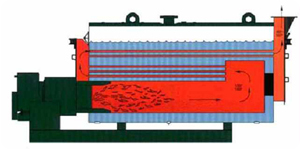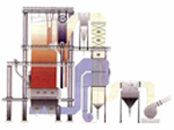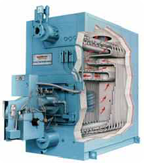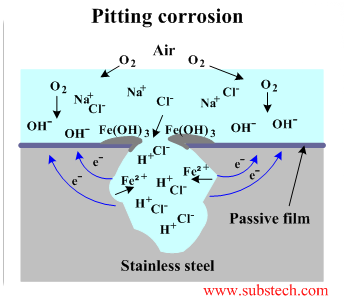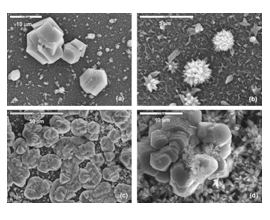|
Steam Boiler System
General Description
Steam boiler is a device used to provide steam by heating water to steam,Steam boiler can be mainly classified into two main categories:
The selection of the boiler or steam boiler type and capacity to be use is depend in many factors as :
The typically steam boiler room design should contain the following equipment :  Common steam boiler water problems.
Pitting corrosion is a direct result to the presence of OXYGEN dissolved gas in boiler water.
Mechanism That a small cavity exists in the surface of the metal into which oxygen cannot diffuse quickly. A current will be produced between the anaerobic area within the cavity, which will become anodic, and the aerated part of the surface outside, which will be the cathode; soluble salt will be formed at the anodic surface within the cavity, but this will not, of course, interfere with further anodic attack. At the mouth of the cavity where the soluble metallic salt from the interior mixes with the alkali from the cathodic part outside, hydroxide may be precipitated, but it will not put a stop to the anodic attack proceeding within. Since the rate of attack is determined by the supply of oxygen to the whole surface outside the pit, and since it is all concentrated on the small area within the pit, the rate at which the corrosion bores into the metal will be very great. Factors affecting pitting corrosion rate Caustic corrosion occurs when caustic is concentrated and dissolves the protective magnetite (Fe3O4) layer, causing a loss of base metal and eventual failure. Caustic conditions caused scabbing and pitting of these heat exchanger tubes in a shell boiler. Attention to the correct control of boiler water chemistry is crucial in preserving the health of the waterside.
Factor effecting scale formation : 1- Heating. Scale problems in steam boiler : 1- Increased fuel consumption and decreasing the operating efficiency. Theory Dispersion of particles : Synthetic polymers control deposition in three specific ways :
The primary purpose of condensate treatment is to protect condensate equipment and piping. In addition, it is important to prevent corrosion products from returning to the boiler. The mechanisms of condensate corrosion are mainly based on : 1-Carbonic acid attack :The carbon dioxide being issued from :
3-Organic acid. NOTE The degree of acid corrosion protection afforded by a neutralizing amine depends on :
Taking into account the information we have got, mixture of amines is judged preferable for wider protection of different condensation zones.
|
||||||||||||||||||||
 |
 |
||||

